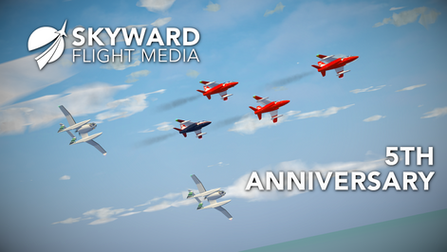
As this unexpected Star Wars first-person space dogfighter nears one year since its release, the combat style is still firmly within everything you'd expect from a Star Wars title. Throughout my experience of both casually and seriously playing this title, there are times when you genuinely feel like you're a hotshot space pilot flying through settings similar to your most beloved Star Wars movie or TV moments. Taking down starfighters with blasters at point-blank range, skimming across the hulls of massive warships dropping energy bombs, and even the more game-specific elements that involve launching drones to repair allies and target markers to track enemies aren't too far outside of the "Star Wars experience." But, as an atmospheric pilot that's used to beyond visual range engagements being the bread and butter of aerial combat, there's a noticeable lack of BVR combat.
To be fair, that's understandable considering that the true-to-screen Star Wars starfighter combat experience is all within visual range (WVR) combat. Even the use of missiles on film is done with the enemy well within sight. Though, there is an auxiliary weapon in Star Wars Squadrons' action that qualifies as medium ranged combat, which can come in handy against the mighty capital ships players must work together to overcome: Torpedoes.
The torpedoes within this game are the slowest moving auxiliary weapon and are hopelessly ineffective against enemy starfighters. But the damage they deal is staggering and can completely change the course of a battle, if they can reach their targets. When viewing the Capital Ship Value document, which is a part of the r/CompetitiveSquadrons Community Knowledge Compendium, it's evident that a single craft deploying these weapons is capable of impairing the shields of a battlecruiser or decimating a vital subsystem on a Star Destroyer almost in just a few solid hits. The damage output that could be achieved by two or more players using coordinated attacks or concentrating fire on a single subsystem could be matched by a single player at a somewhat safer distance.
The three torpedoes in question that are capable of these debilitating long-range strikes are:
Ion Torpedo: deals high damage to shields (24,000 ion damage), capable of knocking down a full power flagship's shield with two hits. Striking a subsystem with these can disable them for a time but will not destroy them.
Proton Torpedo: provides the most damage per torpedo (4,000 hull damage), making it capable of destroying a subsystem with two successful hits from these weapons.
Piercing Torpedo: a specialized torpedo capable of slipping through enemy shields while still dealing moderate damage (2,000 hull damage) to the hull and subsystems.
The natural adversaries of torpedoes are the shields of capital ships, rocket turrets deployed by support craft, interception fire from laser turrets, and blaster fire from keen human-controlled starfighters that are well versed with their onboard sensors to detect them or notice the faint glow they emit while in flight.
Whether you're battling against other human pilots or AI bot adversaries, the battlefield is truly alive in the Fleet Battles game modes. Besides the three primary capital ships and roving corvette escorts exchanging laser and missile fire, non-player-controlled starfighters also crisscross the area. This constant activity in the combat zone acts as a type of cover for the torpedoes as they fly towards their targets. Torpedoes are often overlooked since most players are focused on pursuing their objectives and combating enemies actively maneuvering against them. A lumbering torpedo that seems to be aimlessly wandering through the battlefield is no danger to a highspeed starfighter, so mentally, they become a low priority for players dealing with more forefront threats.

While players can launch torpedoes at a minimum of 500 m - the minimum locking distance for most guided weapons - their ability to lock and launch at 1500 m is a crucial strength as long as players remember to remain near maximum distance when launching these torpedoes. Launching them at 500 m is a viable tactic depending on the situation, but at this distance, the ship launching the torpedoes will be well within the range of laser turrets and starfighters defending the capital ships that are most likely already actively firing upon them. The launch of a torpedo at that range will be easy to detect and easy to intercept seconds after it was launched. Again, with most of the action being WVR combat, there are plenty of opportunities to take advantage of the close-ranged melee to sneak medium range attacks with heavy-hitting torpedoes for surgical strikes against specific capital ship subsystems - which is the primary objective of Fleet Battles.

When focusing on maximum range engagements, the only other weaponry in-game that can pair with torpedoes are various types of missiles. These are the less powerful but more maneuverable counterparts to torpedoes that can be used against starfighters as well as larger targets. Pairing missiles with torpedoes can provide an effective one-two punch for players using load-outs specialized in disabling and destroying capital ships over everything else.

Quietly destroying half of the systems on a Star Destroyer while tiptoeing around an epic dogfight isn't as hilarious as SPAMRAAMing in a F/A-18C Hornet, but successfully landing heavy hits in key moments to obtain victory makes medium range combat in Star Wars Squadrons worth the unusual approach to its standard combat experience.
About the Writer
Aaron "Ribbon-Blue" Mendoza

Co-founder of Skyward Flight Media. After founding Electrosphere.info, the first English Ace Combat database, he has been involved in creating flight game-related websites, communities, and events since 2005. He explores past and present flight games and simulators with his extensive collection of game consoles and computers. Read Staff Profile.














.png)